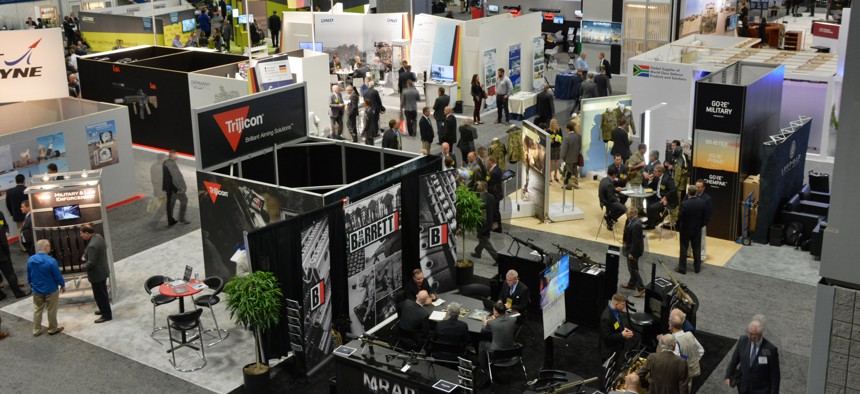
There are more than 600 exhibitors at this year's annual meeting of the Association of the United States Army. AUSA
Where Are All the Startups?
Pentagon leaders regularly tout Silicon Valley innovation, but entrepreneurs seem largely absent from the largest defense industry events.
Wander the exhibit floors of the military’s largest conferences this fall, and you’ll see everything from ground combat vehicles to veteran-trained service dogs, from bit players hawking flooring for overseas installations to industry giants showing off futuristic ideas. One thing you won’t see much of, if at all? Startups.
Pentagon leaders regularly laud Silicon Valley-esque companies and have repeatedly said that harnessing entrepreneurs’ innovative ideas is crucial to the U.S. military’s qualitative edge. Just this month, Defense Secretary Ash Carter announced the Pentagon will be opening a third Defense Innovation Unit Experimental facility in Austin. But that praise—and a planned $65 million in investments funneled through DIUx—have yet to translate to booths on the ground. At the Air Force Association’s annual Air, Space and Cyber conference last month, for example, none of the 120-plus exhibitors were what might conventionally be called a startup.
“Why would you expect to see a millennial at the opera?” said Air Force Gen. Ellen Pawlikowski, who leads Air Force Materiel Command. “By that I mean, the forum that’s here for AFA, a booth concept, is not the environment that the entrepreneurial community they engage with is one that they come to. It’s not of interest to them.”
A smattering of small businesses
That’s not to say that there aren’t small businesses at AFA and the other large conferences, tucked amid the sprawling exhibits from the likes of Boeing, Lockheed Martin, and Northrop Grumman.
This week’s Association of the United States Army conference has a program, now in its fourth year, that grants small businesses a membership-free trial exhibit at the show, AUSA Industry Affairs Director Michael Scanlan said. This year, the program accounts for more than 80 of AUSA’s 600-plus exhibitors.
It doesn’t specifically target startups, because “that’s not how I look at the market,” Scanlan said. What matters is the company’s interest in working with the defense industry, not its age, growth plans, or a self-designation as a startup, he said.
“We’ve had a steady stream of interest from smaller, more nimble companies,” Scanlan said. “We try to provide the Army with an opportunity to talk to small businesses and learn from them.”
But even though small businesses generate innovative ideas and can share characteristics with startups, the two are not synonymous, the Air Force’s Pawlikowski said. It’s the younger, entrepreneurial startups that are even less likely to be found at traditional industry conferences. Only a handful of the companies in AUSA’s three small business pavilions, for example, were created in the last decade.
Hurdles to participating
Part of it’s a financial calculation. Larger defense contractors can easily account for the time and resources it takes to develop and man a sufficiently impressive booth for a three-day show, said Andrew Borene, a management consultant with executive experience both at IBM and a microrobotics startup. That becomes a difficult calculus for small, cash-strapped startups.
“When you’re talking about those massive-scale shows, they’re long shows, sometimes three or more days,” Borene said. “If you’re a lean startup, you’re not only paying for booth space, you’re taking sellers out of the field for that time. There are small businesses, but they’re generally across that five-year operating hump, they’re not really quite a startup business. Typically they’re there because they have enough operating capacity and stabilized capital.”
Then there’s the cost of the space itself. A 10-by-10-foot plot, the smallest stand offered at both AUSA and AFA’s conferences, runs about $5,000—before membership dues to either organization. Though it’s not significantly more than the thousands it costs to exhibit at a few of the biggest tech conferences or innovation-focused events like SXSW, it’s orders of magnitude greater than the fees for a number of startup-oriented conferences.
Companies have to decide to invest that capital relatively far in advance as well. A week after AFA’s conference wrapped up, they had already sold 83 percent of the floor space available next year, according to an official. Medium-term prospects like that, as well as the longer-term investments in industry association memberships, aren’t always possible for small businesses and startups, Scanlan said.
“It’s challenging for a small business,” he said. “Their business cycles move so fast.”
And purchasing booth space a year in advance is one of the shorter lead times startups will encounter when working with the military industrial complex. Protracted acquisition timelines and complicated regulations can turn off entrepreneurs who might otherwise be interested in working with the military, said Gen. Paul Selva, the vice chairman of the Joint Chiefs of Staff.
“There are startup companies that are interacting with the department and with the Air Force,” Selva said, speaking on an AFA panel with Pawlikowski. “But they don’t find themselves comfortable in the environment we’ve created. They are not comfortable inside the Federal Acquisition Regulations, and they’re certainly not comfortable on the long lead time and very long development cycles that we normally bring to programs.”
Hidden, but not entirely absent
One way to “see” startups on the floor? Look to the products and innovations the biggest companies are displaying. The largest contractors play an integrating role with the rest of the industry, from collaborating on specific offerings to sponsoring startup incubators, said Bernie Skoch, the coordinator of the AFA conference.
“If you stroll the booths...you’re not going to see [startups’] logos or their brands on the floor necessarily,” he said. “But a lot of the integrators, each one of the primes, they partner with startups, small businesses, those non-traditional companies.”
For those startups not already wrapped into one of the big contractors’ fold, purchasing exhibit space is the most visible way to participate at the large conferences, but it’s not the only one. Skoch said a number of small businesses and startups have connected with the association’s other members by sponsoring a panel or tables at the receptions, although AFA does not make those sponsorship lists public. And multiple sources said walking the floor as an attendee—rather than exhibiting on it—can prove just as fruitful for smaller-staffed startups.
“I have seen people from companies that are small and in startup phase buying a full access ticket and having a lot of success,” Borene said. “That’s the other reason you’re not seeing them on the exhibit floor. It’s a guerrilla tactic...a smart startup CEO is leveraging every angle.”
Another viable option is one of any of the shorter conferences outside the D.C. Beltway that still provide a “safe, ethical means for startups to get access” to military leaders, acquisition officials and potential partners, Borene said.
“If you’re a small [company], you kind of have to be a contrarian—you’ll get drowned at AUSA,” Borene said. “But if you go to some of the smaller ones, they tend to be a day or at most two days, so you’re not burning resources manning a booth.”
Meeting in the middle
Whether it’s through formal exhibits or informal conversations at AUSA’s or AFA’s summits, a DIUx award, or another avenue, the military has to find environments in which startups are comfortable, Selva said.
“What we have to do, and what we have been doing is trying to nurture relationships with those small companies by placing bets and asking them hard questions and giving them some time to chew on them,” Selva said.
That increased engagement with small entrepreneurs might not translate to a significantly larger startup presence on the exhibit floor, or even a desire for it. Though the AFA hasn’t wrapped up its post-conference survey from attendees and exhibitors, Skoch said they hadn’t yet received any feedback requesting a greater startup presence on the floor.
“We haven’t completely tabulated the data, but what we heard from the exhibitors is this was one of the most engaged years, the busiest they’ve seen the floor,” he said. “I have not heard a specific desire for non-traditional exhibitors.”
Recognizing the difficulties startups face when engaging with the large-scale conferences, the Air Force and other services have started to meet them where they’re most comfortable instead, Pawlikowski said.
“We have to reach out to the forums they’re participating in,” she said. “I, personally, out in Los Angeles participated in a venture capitalist conference to talk about space … After I participated in a panel, I had about a dozen venture capitalists come up to me, wanting [me] to know that they had entrepreneurs that were interested in getting involved.”
Outreach like that is starting to return dividends, Borene said. Startups may not be expressing their interest by purchasing booths at the massive industry events, but they are expressing it. He pointed to organizations like Eastern Foundry, which has created a homebase with office space and resources just down the road from the Pentagon for startups interested in the defense sector.
“The Pentagon, with its giant bureaucracy, is making all of the right moves in embracing and getting out to the clusters of ingenuity in the civilian sector, and on the other side, you’re seeing those entrepreneurs aggregating here in DC in order to start addressing that need,” Borene said. “The macro trends are all moving in the right direction to start seeing innovation in the defense industrial base.”
